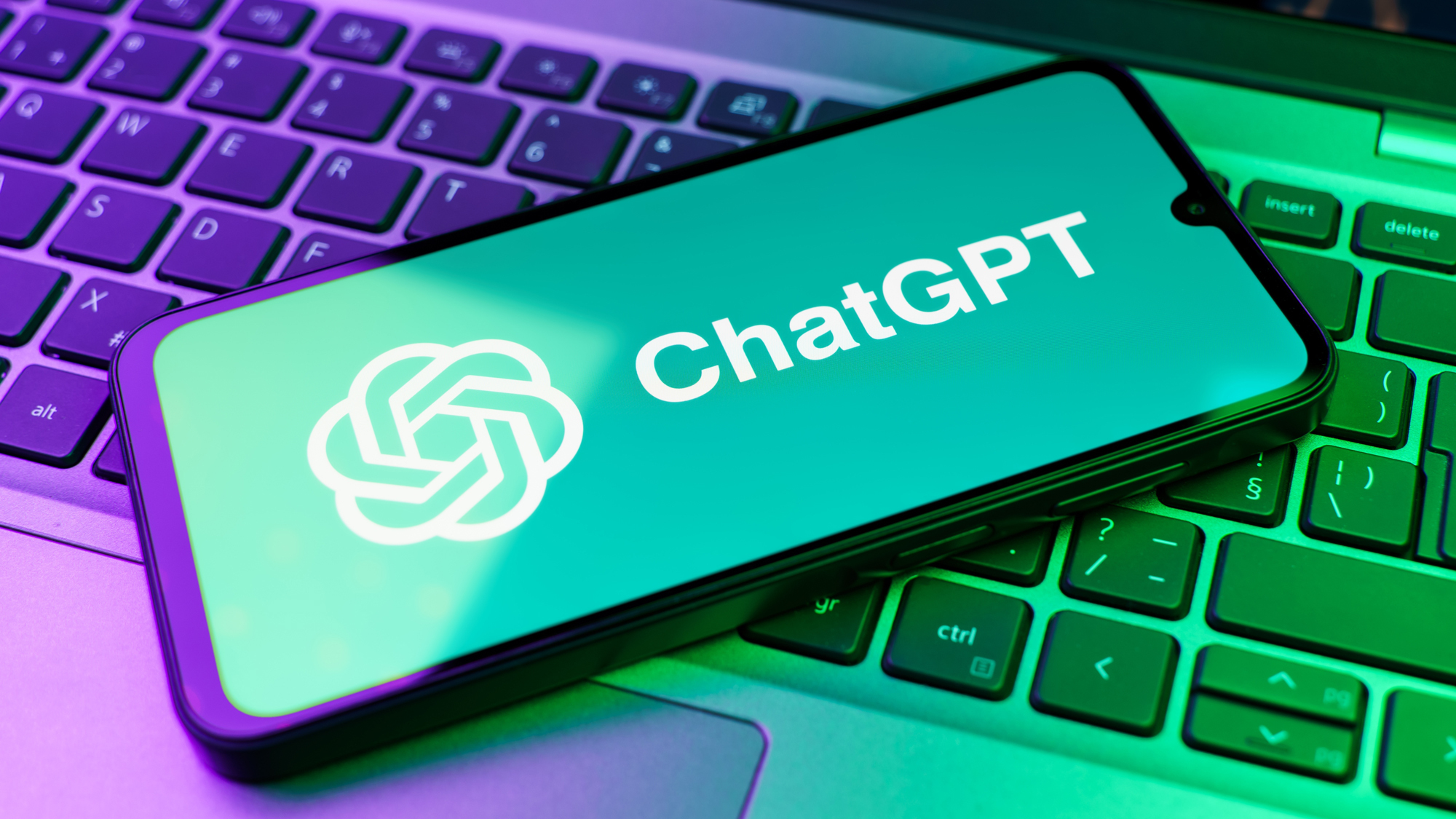I stopped using punctuation in my prompts — here’s why I swear by it now
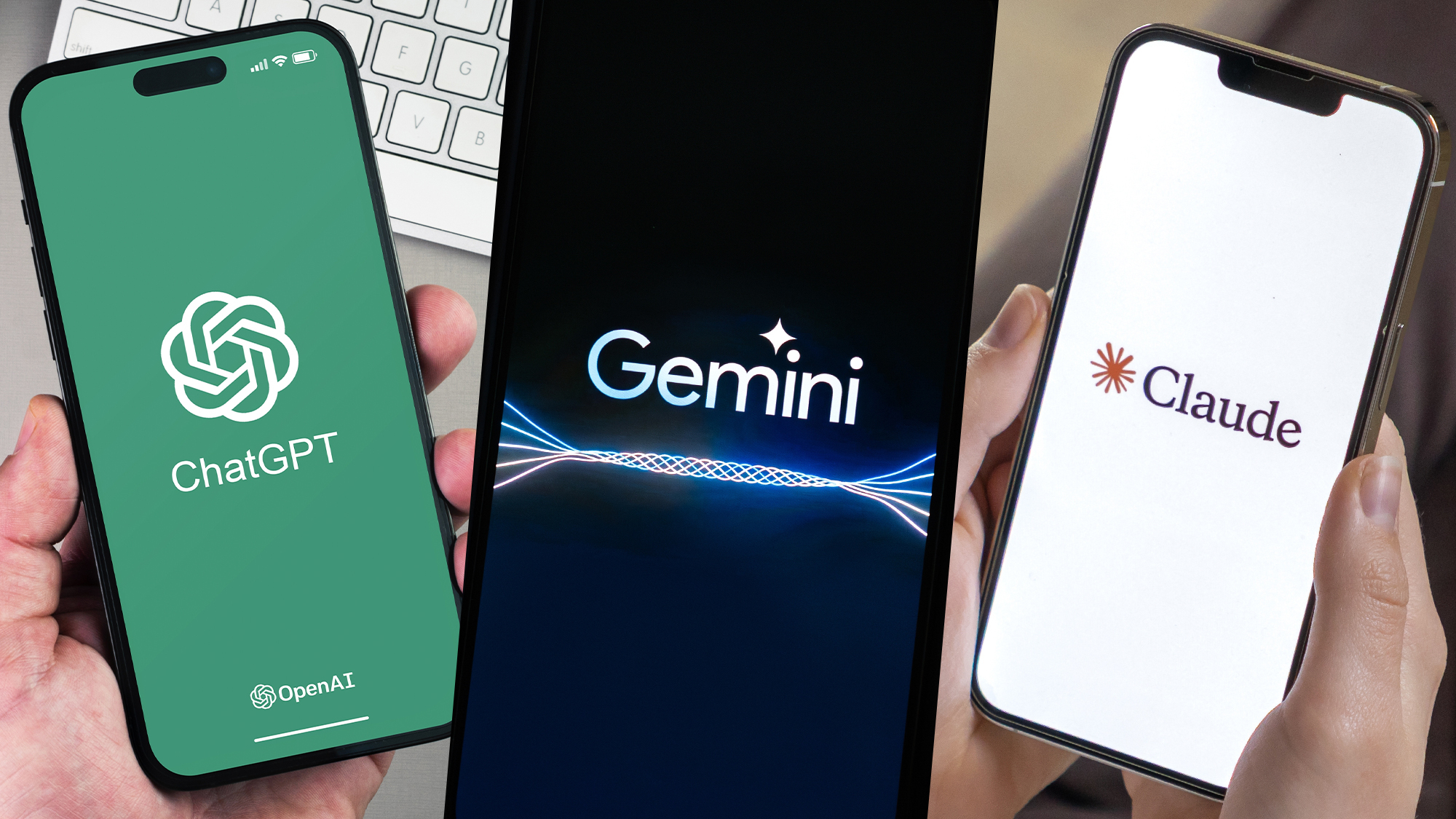
Do you really need punctuation, spell-check and proper grammar when chatting with AI? I’ve tested how being polite alters response, so I just had to know if the tone and content of chatbot replies changed based on whether I typed properly or as if I was texting with my eyes closed.
To find out just how much punctuation (or the lack of it) shapes AI responses, I tested a range of prompts on several different chatbots including Gemini, Claude and ChatGPT.
I tested everything from blog brainstorming and birthday messages to breaking news and weekend planning — all in two versions: buttoned-up and grammar-perfect vs. casual, typo-riddled. I even threw in an emoji prompt for fun.
The differences were far more revealing than I expected.
1. Creative ideas
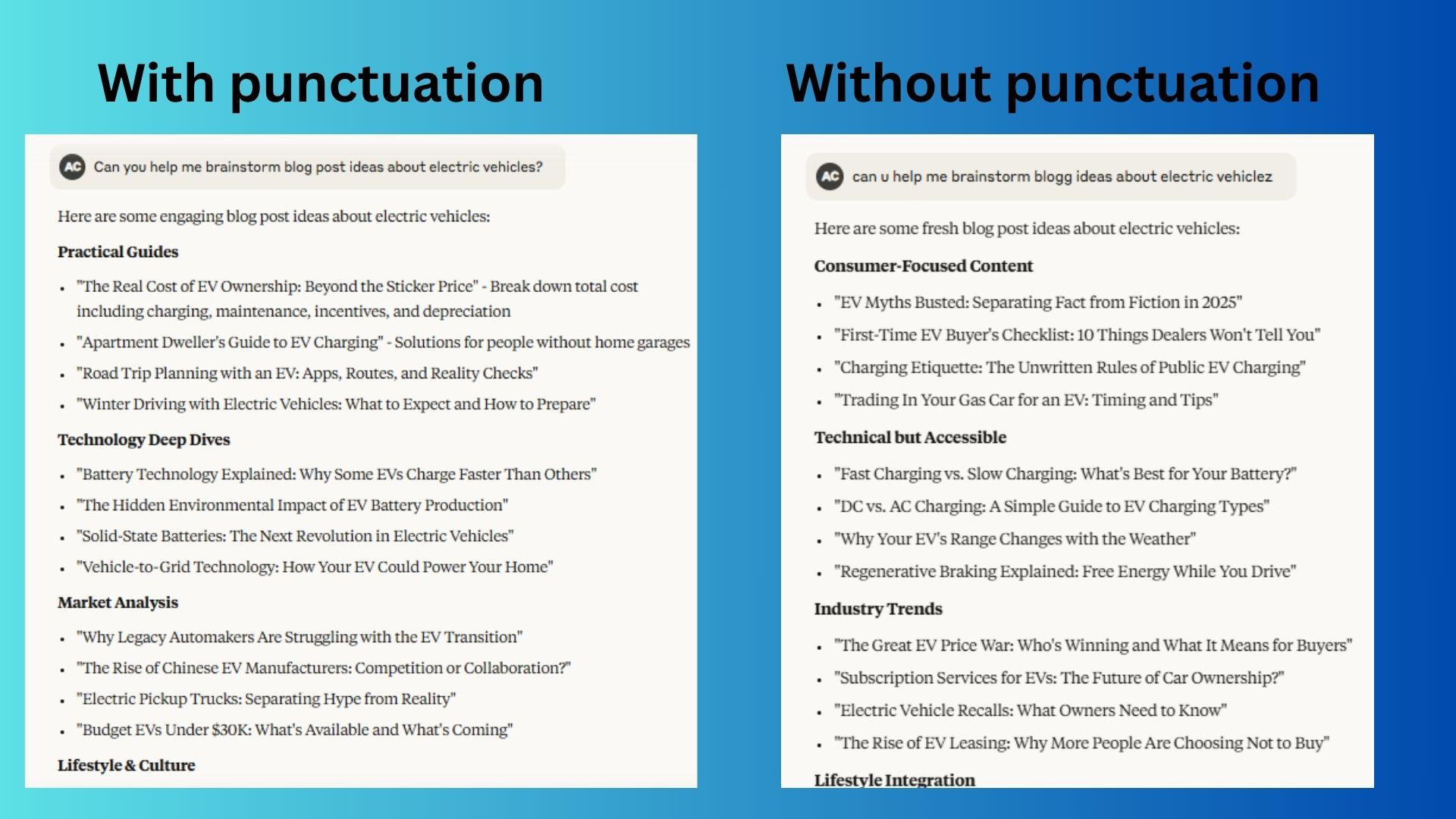
Prompt 1: “Can you help me brainstorm blog post ideas about electric vehicles?”
Prompt 2: “can u help me brainstorm blogg ideas about electric vehiclez”
Punctuation: This take is definitely geared toward readers who want the big picture. People who care about where the EV market is going, not just where it is today. It leans analytical and future-forward, touching on tech trends, policy implications and how EVs fit into broader conversations about sustainability and innovation.
No punctuation & errors: This one is more grounded and relatable; it's the version that speaks directly to people trying to figure out if an EV is right for their life right now. It’s less about macro trends and more about everyday decisions: charging logistics, cost savings and what it actually feels like to own and drive an EV.
Results: With punctuation, the chatbot zoomed out, focusing on the bigger picture like tech trends, sustainability and market direction. Response 2 zooms in for results about the everyday experience of owning an EV, offering practical insights for mainstream consumers and potential buyers.
2. Tone-based writing
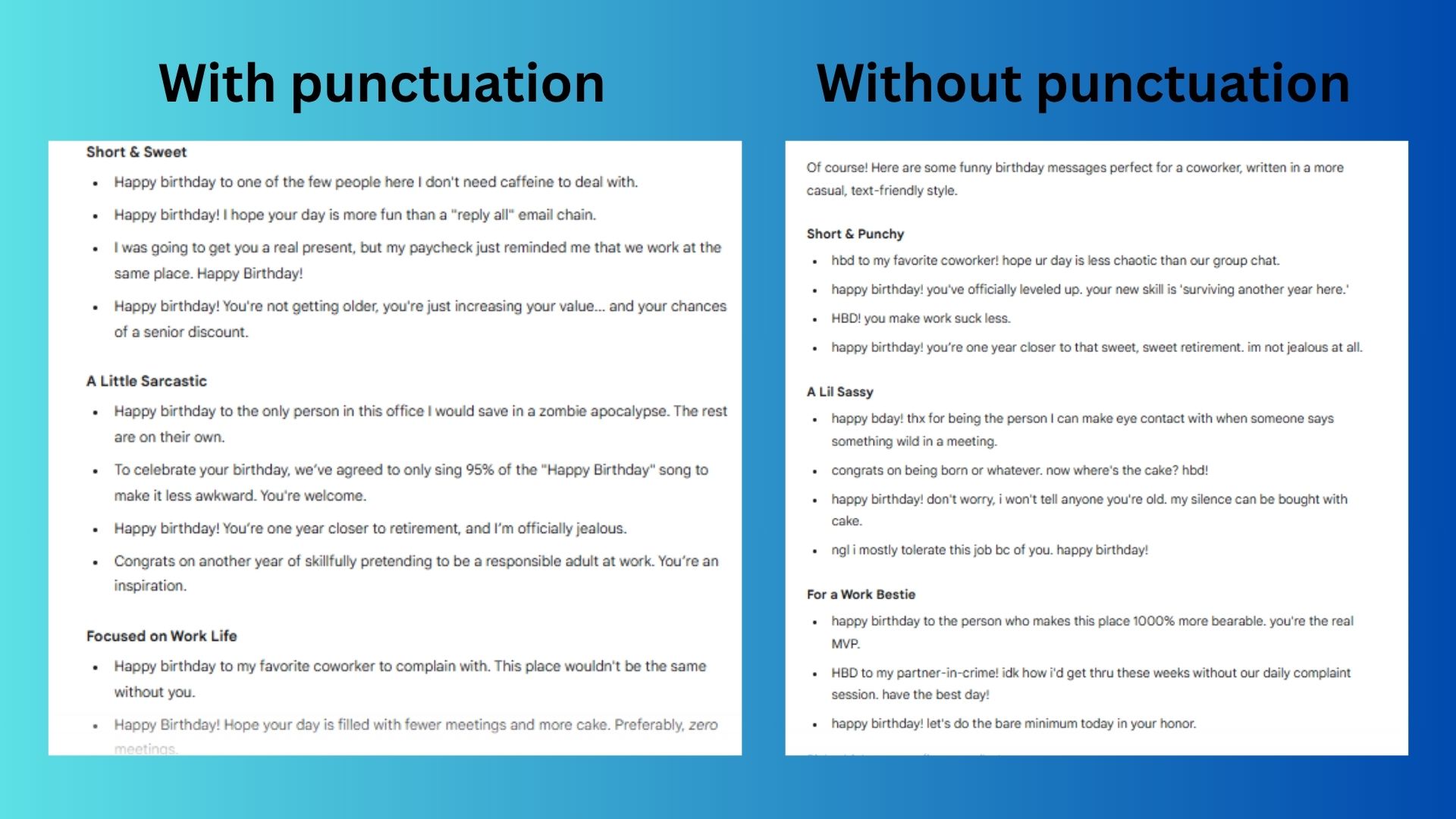
Prompt 1: “Write a funny birthday message to a coworker!”
Prompt 2: “write a funnie bday msge to a coworker”
Punctuation: More polished and structured. Uses full sentences, proper grammar, punctuation and slightly more formal language (e.g., "significantly less of a drag," "skillfully pretending," "tangible asset"). Humor is witty and situational.
No punctuation & errors: More casual and conversational, mimicking texting/informal chat. Uses abbreviations ("hbd", "ur", "bc", "ngl"), slang ("suck less", "wild", "bare minimum") and shorter, punchier phrasing. Humor is more direct and sometimes edgier.
Results: With punctuation, the response is clean, composed and leans into clever, well-crafted language with a polished tone and structured delivery. Without punctuation, the response is looser and more spontaneous, using internet slang and a casual voice that feels like a text from a friend.
Get instant access to breaking news, the hottest reviews, great deals and helpful tips.
3. Real-time news
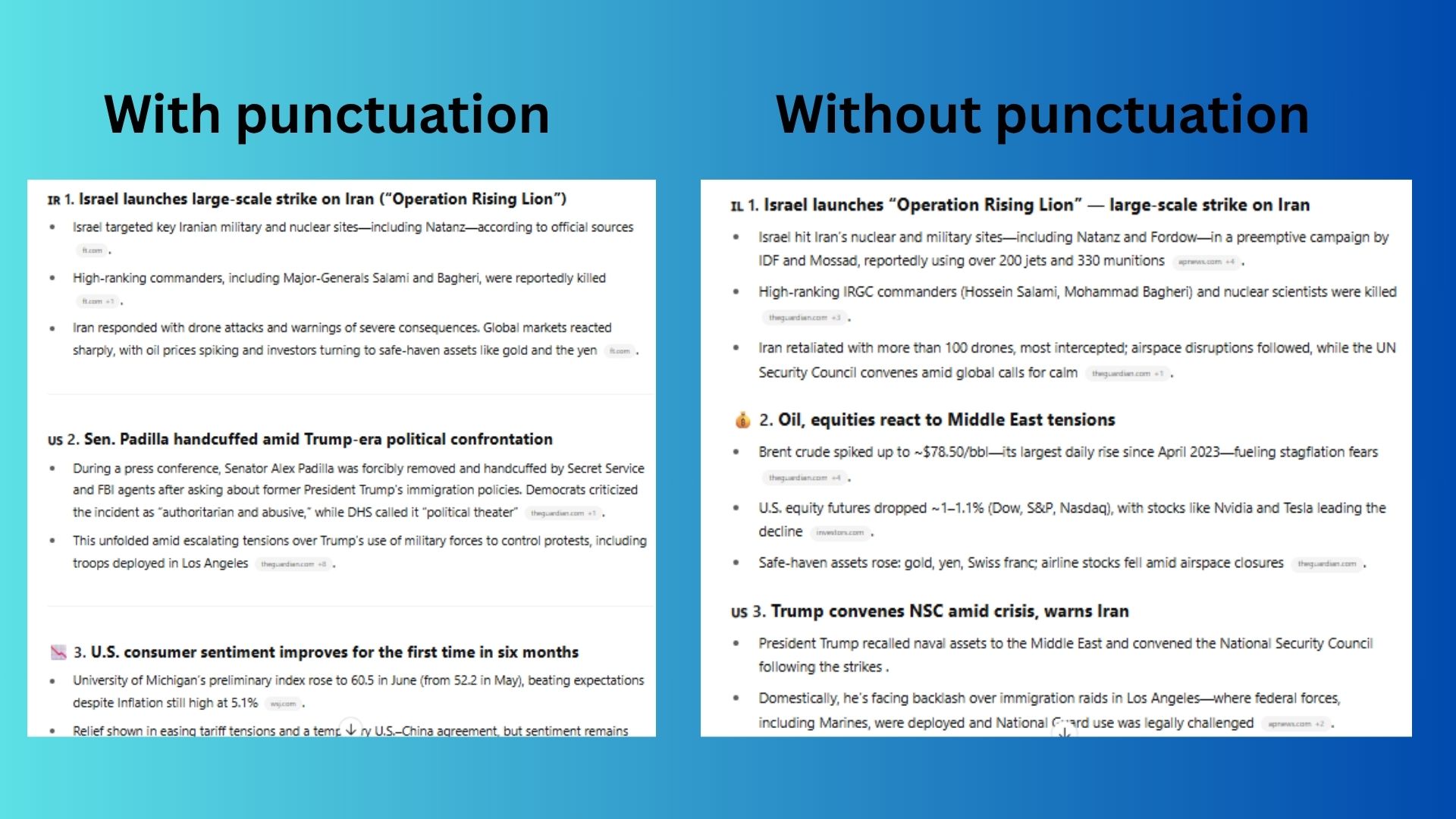
Prompt 1: "Please tell me the top current news stories."
Prompt 2: "plz tell me the top curentnews stories"
Punctuation: Leads with Israel's strike on Iran ("Operation Rising Lion") but provides less tactical detail. Focuses on broader impacts (global markets, Iran's response). Includes Sen. Padilla's arrest as a separate major story.
No punctuation & errors: Leads with far more detailed military specifics of Israel's strike (targets: Natanz + Fordow; scale: 200 jets, 330 munitions; agencies: IDF + Mossad). Immediately follows with a dedicated section on market reactions (" Oil, equities react...").
Results: The prompt with punctuation delivered a broader, multi-story news roundup with geopolitical and market context; lighter on specifics. The prompt without punctuation felt like it was tactical-heavy with a focus on financial fallout and really no secondary news.
4. Emoji vs. No emoji

Prompt 1 without emoji: “Suggest weekend activities.”
Prompt 2 with emoji: “suggest wknd activities *smiley emoji*”
Without emoji: Highly structured and categorized by activity type (Outdoor, Cultural, Social, Relaxing, Learning), offering a comprehensive menu of activities. It ends with a practical question.
Emoji: Emphasizes fun, spontaneity and uplifting experiences (e.g., "spontaneous road trip," "backyard movie night," "karaoke night"). Features more whimsical, playful and novelty-focused activities like apple picking, mini golf, stargazing, escape rooms or visiting sunflower fields.
Results: Without an emoji in the prompt, the response is more structured and utilitarian, offering categorized options based on activity type and ending with a practical, mood-based decision prompt. The response completely changed with an emoji with a more playful and emotionally driven tone, focusing on spontaneous, feel-good activities and an emphasis on immediate joy.
5. Multi-step instructions

Prompt 1: “I have a busy weekend and am trying to organize my schedule. I have to do laundry, organize the basement, attend a soccer tournament and celebrate Father’s Day. Help me plan.”
Prompt 2: “i have a busy weekend and am trying to organize my schedule i have to do laundry organize the basement attend a soccer tournament and celebrate fathers day”
With punctuation: Although the responses are very similar, the response with punctuation is slightly more rigid.
Without punctuation: This response offers flexibility and acknowledges unpredictability.
Results: The response with punctuation feels more structured and formal, offering a clear but slightly rigid tone. In contrast, the version without punctuation conveys more openness and adaptability, reflecting a looser, more conversational style.
Final thoughts
So, does punctuation matter when you talk to a chatbot? Surprisingly, yes! But maybe not in the way you think. Using punctuation tends to make the AI sound more polished, structured and formal, often zooming out to give big-picture takes.
Leave it out, and the tone shifts to something looser, more conversational and often more practical or emotionally resonant.
In the end, the “right” way to prompt depends on what you’re looking for: thoughtful analysis or text-from-a-friend vibes. Either way, the choice is yours. Period (or no period, your choice).
More from Tom's Guide
- OpenAI just made 5 major moves — what it means for you and ChatGPT
- I used ChatGPT to future-proof my career — and here’s how you can too
- Calling it now — this will be the hottest AI toy of the holiday season

Amanda Caswell is an award-winning journalist, bestselling YA author, and one of today’s leading voices in AI and technology. A celebrated contributor to various news outlets, her sharp insights and relatable storytelling have earned her a loyal readership. Amanda’s work has been recognized with prestigious honors, including outstanding contribution to media.
Known for her ability to bring clarity to even the most complex topics, Amanda seamlessly blends innovation and creativity, inspiring readers to embrace the power of AI and emerging technologies. As a certified prompt engineer, she continues to push the boundaries of how humans and AI can work together.
Beyond her journalism career, Amanda is a long-distance runner and mom of three. She lives in New Jersey.
You must confirm your public display name before commenting
Please logout and then login again, you will then be prompted to enter your display name.










